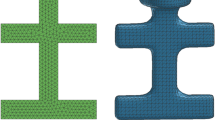Abstract
The present study describes the possibilities of new experimental and numerical methods to predict the crack susceptibility of steels under continuous casting (CC) conditions. The first method—the In-Situ Material Characterization by Bending (IMC-B) Experiment allows measuring the critical strain values for surface defects upon all the most important process and material parameters. The IMC-B experiment uses solidified samples obtained directly from the melt and is based on the 3-point bending test. Strains are calculated directly after the experiment has used a simulation in Abaqus. The risk of surface cracks is shown by using the new numerical tool, so-called defect indices implemented in IDS. In the framework of practical series, a crack susceptibility of the commercial Nb-microalloyed steel is investigated after the subsequent cooling to the test temperature. Samples cast at two different cooling conditions show another distribution of surface defects and critical strain value.
Zusammenfassung
Die vorliegende Publikation beschreibt neue Methoden der experimentellen und numerischen Prognose der Rissanfälligkeit von Stählen unter Stranggießbedingungen. Die erste Methode – In-Situ Material Characterization by Bending (IMC-B) – ermöglicht während des Biegeversuchs die Messung der kritischen Dehnungen zur Oberflächenrissbildung unter den wichtigsten Prozess- und Materialparametern. Der IMC-B Versuch basiert auf dem 3-Punkt Biegeversuch unter Verwendung einer direkt aus der Schmelze erstarrten Probe. Die Dehnungen werden direkt nach dem Experiment mit Hilfe von Abaqus berechnet. Die Gefahr der Rissbildung ist durch numerische Simulationen, mit sogenannten Defekt Indizes, dargestellt. Diese Defekt Indizes sind in IDS implementiert. Im Rahmen der Versuchsserie wird die Rissanfälligkeit eines Nb-mikrolegierten Stahls nach der anschließenden Abkühlung bis auf Raumtemperatur untersucht. Die bei zwei unterschiedlichen Abkühlbedingungen gegossenen Proben zeigen eine andere Verteilung der Oberflächenrisse sowie unterschiedliche kritische Dehnungswerte.











Similar content being viewed by others
References
Xie, S. S.; Lee, J. D.; Yoon, U.–S.; Yim, C. H.: Compression test to reveal surface crack sensitivity between 700 and 1100 °C of Nb-bearing and high Ni continuous casting slabs, ISIJ International, 42 (2002), no. 7, pp 708–716
Yasunaka, H.; Narita, K.; Mori, T.; Fujimoto, T.: On the surface cracks caused by the bending test of small ingot, ISIJ Meeting, 101 (1981), pp 136
Yasumoto, K.; Maehara, Y.; Nagamichi, T.; Tomono, H.: Effect of thermal-mechanical history on surface cracking of as cast low carbon low alloy steel slabs, ISIJ International, 29 (1989), no. 11, pp 933–939
Crowther, D. N.; Green, M. J. W.; Mitchell, P. S.: The influence of composition on the hot cracking susceptibility during casing of microalloyed steels processed to simulate thin slab casting conditions, Materials Science Forum, 284–286 (1998), pp 469–476
Mintz, B.; Yue, S.; Jonas, J. J.: Hot ductility of steels and its relationship to the problem of transverse cracking during continuous casting, International Materials Reviews, 36 (1991), no. 5, pp 187–217
Bernhard, C.; Krajewski, P.; Schaden, T.; Ilie, S.: Fachausschuss für physikalische Chemie und metallurgische Verfahrensentwicklung des VDEh, Präsentation, Düsseldorf, 28.03.2014.
Louhenkilpi, S.; Miettinen, J.: Project Report SolCrack II, February 2014, Linz
Andersen, I.; Grong, O.: Analytical modeling of grain growth in metals and alloys in the presence of growing and dissolving precipitates—I. Normal grain growth, Acta metal, Mater, 43 (1995), no. 7, pp 2673–2688
Bernhard, C.; Reiter, J.; Presslinger, H.: A model for predicting the austenite grain size at the surface of continuously-cast slabs, Metallurgy and Materials Transactions, 39B (2008), pp 885–895
Author information
Authors and Affiliations
Corresponding author
Rights and permissions
About this article
Cite this article
Krajewski, P., Krobath, R., Bernhard, C. et al. A Novel Approach for the Simulation of Surface Crack Formation in Continuous Casting. Berg Huettenmaenn Monatsh 160, 109–116 (2015). https://doi.org/10.1007/s00501-014-0308-3
Received:
Accepted:
Published:
Issue Date:
DOI: https://doi.org/10.1007/s00501-014-0308-3




